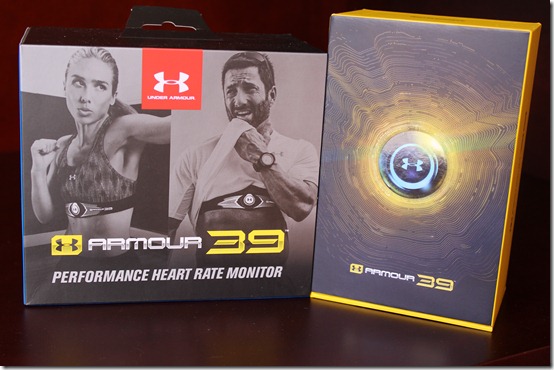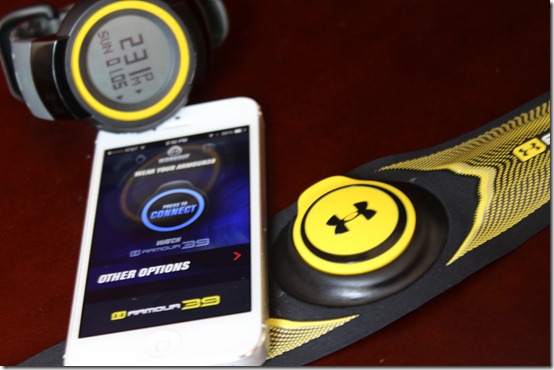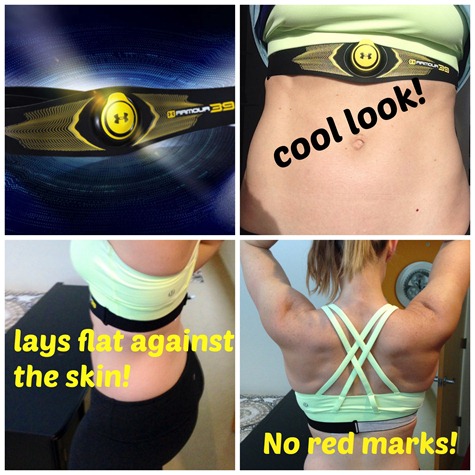Some thoughts and discussions from me.
the following post is sponsored by fitfluential LLC on behalf of Under Armour.
I recently received the new Armour39 Fitness and Heart Rate Monitor. I love any and all gadgets, but there’s a special place in my heart for gadgets that have to do with fitness! I’ve never used any sort of fitness tracker (only HR monitors) so I was pretty excited to read all about and use my Armour39.
When I first started getting serious about fitness, I wore a HR monitor all of the time. It was a good indicator of how hard I was working, if I could push it more, if I should not push it so hard, and so on. Plus, it was cool to see how many calories were burned for different workouts.
Now, I use them a bit differently: for interval training and while teaching indoor cycling.
I tend to do all of my interval training based on heart rate training. For example, I’ll do hill sprints until I hit my max, and then rest until it gets back to the 130’s or 140’s. This is also known as rest-based training. RBT works a lot better than time-based training for one major reason: if you’re unable to get your heart rate down enough during the prescribed rest period, you won’t be able to give 100% during the prescribed work period. And with each interval, the performance will progressively decrease. And while we still want to be tired during the work periods, during intervals, we typically want to give it our all!
Spent. Until my HR comes back down.
For indoor cycling, I’ll often teach in terms of heart rate zones. For example, a certain portion of the ride might sky rocket the heart rate, and then we want to make sure we get back to zone 1 or 2 during recovery. This also helps better our recovery heart rate, which I’ll touch on again in a second.
When I first heard about the Armour39 Fitness & HR Monitor, I was excited to try out a new HR monitor on the market. I know my HR training and HR monitors, how they work, and how they’re best used. I got this. However, when it was delivered to me, I found out it did so much more than just monitor HR and calories burned.
There’s a couple options with Armour39. All together, you have the chest strap and blue tooth module, the iphone app, and the watch. I immediately noticed the quality of the chest strap. Not only is it really cool looking, but it’s also super comfortable. It’s made out of the same fabric Under Armour uses for it’s comfortable clothing!
Another way the Armour 39 chest strap differs from many others is by including a bluetooth-enabled pod in the center, which syncs up with the iphone app or watch.
That little yellow pod is pretty powerful, and tells you quite a bit:
- heart rate and calories burned
- workout intensity
- WILL power
- monthly progress
The orientation sensors on the pod can also sense what kind of position you’re in – so it knows if you’re upright, running sprints, or if you’re horizontal while pushing plates or in a plank, which plays into intensity. The monitor also measures what it calls WILLpower.
Armour39 monitors your WILLpower based on level of exertion, and grades your willpower on a point-system. You can see all of this, and basic watch functions, on the Armour39 watch, and as I mentioned earlier, you can also see all of your real-time stats on the iphone app Armour39.
[source]
Since using Armour39, I’ve always kept my phone nearby during workouts, because it’s cool to see the real-time stats while not wearing the watch. However, although you need the iphone to be in close proximity to the bluetooth module while starting your workout, you don’t need it during your workout. The yellow pod/module keeps track of it the entire time!
Before my first workout with the Armour39, I headed to the treadmill to complete my fitness assessment. It’s basically a 10 minute assessment that has you walk for 2 minutes, jog for 2 minutes, run for 3 minutes, sprint for 90 seconds, and then rest for 90 seconds. During this time, it records your resting heart rate, progressive HR, max HR, and recovery HR. My results were probably skewed, because I completed the assessment after an hour of lifting (I never do cardio – especially sprints – before lifting.)
My max HR is more like 195, not 182, but regardless, it was pretty cool to see – and let me know that I probably could have pushed it a little more during my “sprint” phase ![]()
After completing the assessment, I tried out the tracker during a hike up Mount Sanitas.
This was a day after getting home from Florida, so I think my HR was slightly elevated due to going from 0 ft. above sea level to 6,000 ft. Ya know. Mount Sanitas is a great 2-hr hike that’s a good workout, with lots of big rocky “stairs.” I typically take 2-3 breaks, and this day I took two breaks on the way up, and then stopped for 5-10 minutes at the top. I decided to “stop my workout” shortly into descending the other side of the mountain. It was still kind of icy and snowy, and I wanted to concentrate on not breaking my ankle, rather than tracking my intensity ![]()

I loved all the different summaries the app provides after the workout: overview, heart rate, and intensity.
All in all, I’m really impressed with the Armour39 performance monitor. I think the intensity and WILLpower modes are great for those who are motivated numbers, and I’m obsessed with the chest strap. I also really love all of the different ways the app displays your workout results.
Do you use any sort of fitness tracker or heart rate monitor?









I have had probably 3-4 polars. I like them, but I’d love a different strap. I really really want to try UAs…but I can’t justify the cost of the strap and the watch (and I definitely need the watch). Maybe they’ll go on sale soon 🙂 Great review!
This is interesting! I’ve never used a heart rate monitor before, but I can definitely see how it could be beneficial.
Sam @ Better With Sprinkles recently posted…Five Things Friday 01/10/14.
I’m actually doing rest based strength training right now (first time) and it’s fun! I just got a new HR monitor to make it easier (my GPS is so big for that) and enjoyed the first workout with it. UA needs to get on the Android train. 😉
Heather @ Better With Veggies recently posted…Stay on Track with Office 365 Premium
I’ve heard good things about this HR tracker. I never like wearing the chest straps because they’re so uncomfortable under “the girls” and made even worse being next to the bra strap but hearing that it’s so comfortable made me change my mind. I added it to my Amazon wish list for Christmas, but Santa had other (awesome) ideas, so it looks like I’ll be saving up for a new toy down the line. I keep hearing wonderful things about it and can’t wait to try it myself.
Courtney @ Don’t Blink. Just Run. recently posted…Face The Music Friday #16